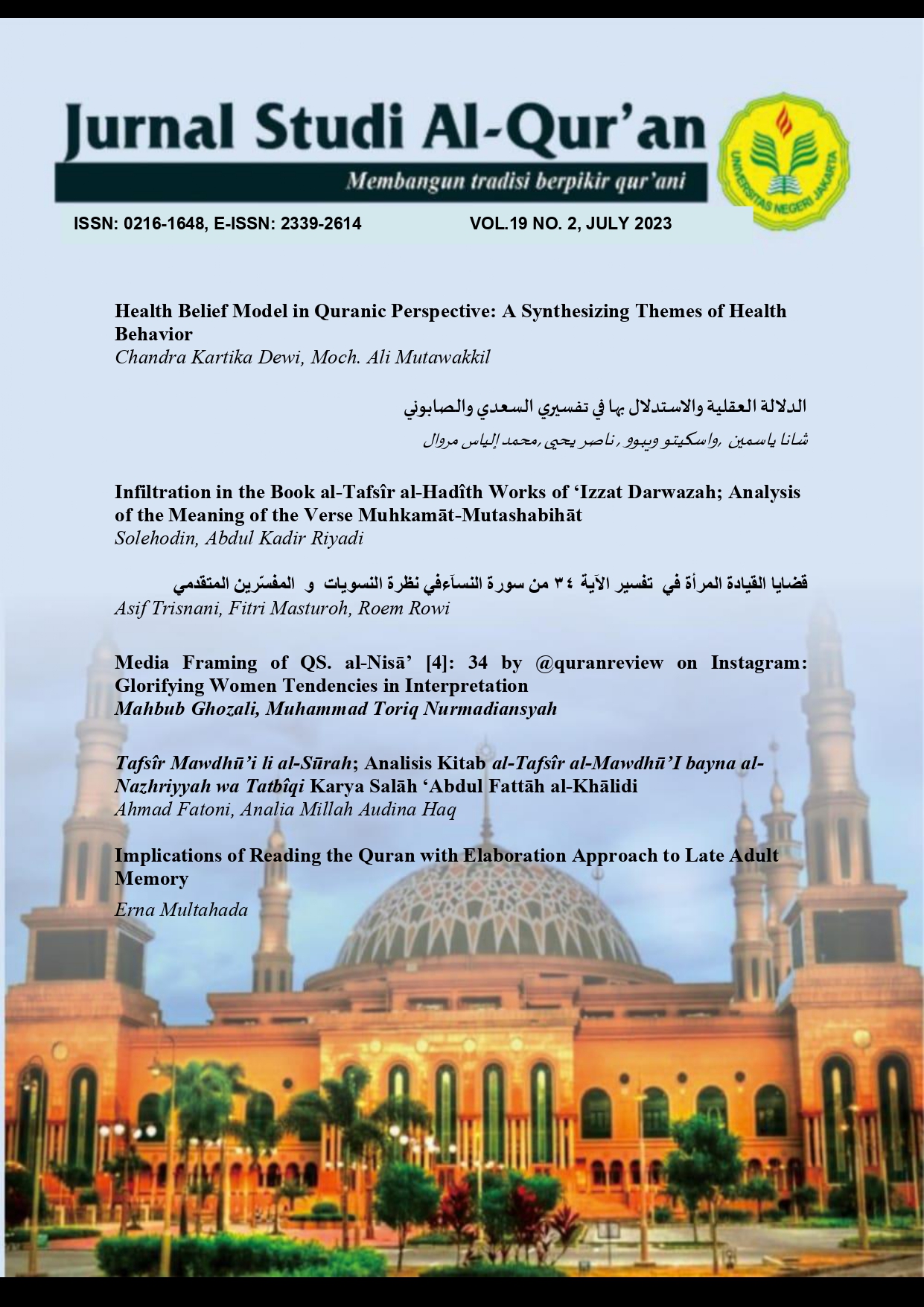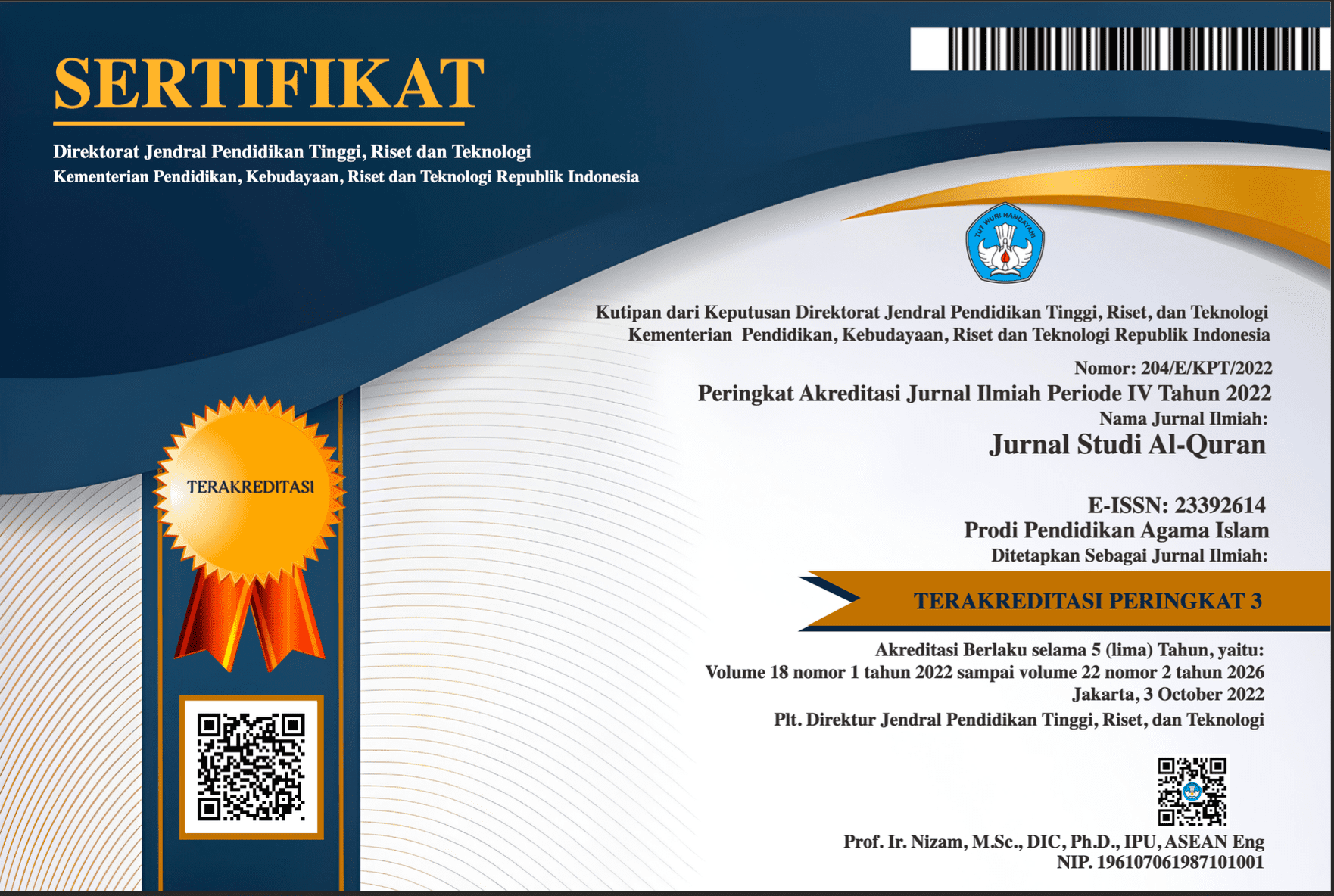Infiltration in the Book al-Tafsîr al-Hadîth Works of ‘Izzat Darwazah; Analysis of the Meaning of the Verse Muhkamāt-Mutashabihāt
DOI:
https://doi.org/10.21009/JSQ.019.2.03Keywords:
Izzat Darwazah, Muhkamāt-Mutashabihāt, Asās-Wasā’il, al-DakhîlAbstract
This article discussed Muhammed Izzat Darwazah’s thoughts in verse Muhkamāt-Mutashabihāt. This article was compiled based on the descriptive qualitative method. They are using library data as a type of Library research. As an analysis step, it uses the basis of comments from contemporary figures Abd Rahîm Fāris Abū Ulbah (b. 1947 AD-present). The results of this study are First, Through theory Muhkamāt-Mutashabihāt Darwazah tries to describe his new findings or make updates (Ihdath) draft. That is Concept Asās al-Qur’ān as an equation with Muhkamāt and aspects Wasā’il. (facilities/support) as an equation with Mutashabihāt. Second, In the theory of ta’wil, Darwazah is an adherent who allows to interpret verses that are Mutashabihāt even more freely because Darwazah uses his approach to Wasā’il. Third, in terms of infiltration (Dakhîl), many weaknesses were found in the theory of Wasā’il as stated by Darwazah (shawā’ib). Among them are not under the provisions of Muhkamāt-Mutashabihāt as agreed by the classical scholars. From a practical aspect, according to Abū Ulbah, it has a weakness. Namely, Darwazah’s theology is less consistent. He includes aspects of faith in Allah in the classification of verses Muhkamāt But on the other hand, in the element of faith, there is life after death, the Day of Judgment and the counter-events at the Last Day are classified under the theory Wasā’il or Mutashabihāt.
References
Baidan, Nashruddin. Wawasan Baru Ilmu Tafsir (Yojgakarta, Pustaka Pelajar, 2016).
Drwazah, Muhammad Izzat. Al-Qur’ān al-Majîd (Beirut, al-Maktabah al-‘As} riyah, tt.)
--------------. al-Tafsir al-Hadith, Cet. 2, Juz 10 (Kairo: Dar al-Gharbî al-Islami>, 2000).
--------------. Nash’at al-Harakat al-‘Arabiyah al-hadithah, Cet 2 (Ttp: Sidon, 1971).
Fayed, ‘Abdul Wahhab. al-Dakhîl fî Tafsîr al-Qur’ān al-Karîm, Kairo:Matba’ah al-Hadharah al-‘Arabiyah, 1978, Juz 1.
Grasiaswaty, N., & Caninsti, R. (2021). Tiga Tema Konsep Kebersyukuran dalam Perspektif Al-Qur’an: Sebuah Literatur Review. Jurnal Studi Al-Qur'an, 17(2), 251-263.
Isnaini, S. N. (2021). The Exegesis of Theological Verses in al-Muh arrar al-Wajiz: Critical Study of the I’tizal Accusations toward Ibn Athiyyah. Jurnal Studi Al-Qur’an, 17(2), 207 - 231. https://doi.org/10.21009/JSQ.017.2.03
Iyazi, Muhammad Alî. al-Mufassirūn Hayātuhum wa Manhājuhum (Ttp: al-Thaqafah al-IrsHadî al-Islamî, tt).
Kusmana, Membaca Hermeneutika Al-Qur’ān Muhammad Izzat Darwazah, Ushuluna: Jurnal Ilmu Ushuluddin Vol. 7, No. 1, Juni 2021.
Mustaqim, Abdul. Metode penelitian al-Qur’ān dan Tafsir, Yogyakarta, Idea Pres, 2019, 1.
Nazir, Moh. Metode Penelitian (Jakarta: Ghalia Indonesia, 2009), 54
Poonowala, Ismail K.“Hermeneutika al-Qur’ān: mengenal al-Tafsir al-Hadits karya Izzat Darwazah,” diterjemahkan oleh Farid S Saneong dalam Jurnal PSQ 1, no. 1 (2006).
Ulinnuha, Muhammad. “Konsep Al-Ashil Dan Al-Dakhil Dalam Tafsir Alquran”, Madania, Vol. 21, No. 2 (2017), 128.
Al-Zarqani, Abdul Azim. Manāhil al-‘Irfān fî Ulūm al-Qur’ān (Beirut, Darul Kitab Al-Arabi 1995).
Downloads
Published
How to Cite
Issue
Section
License
Authors who publish with this Journal agree to the following terms:
- Author retain copyright and grant the journal right of first publication with the work simultaneously licensed under a creative commons attribution licensethat allow others to share the work within an acknowledgement of the work’s authorship and initial publication of this journal.
- Authors are able to enter into separate, additional contractual arrangementfor the non-exclusive distribution of the journal’s published version of the work (e.g. acknowledgement of its initial publication in this journal).
- Authors are permitted and encouraged to post their work online(e.g. in institutional repositories or on their websites) prior to and during the submission process, as it can lead to productive exchanges, as well as earlier and greater citation of published works.
Users/public use of this website will be licensed to CC BY










